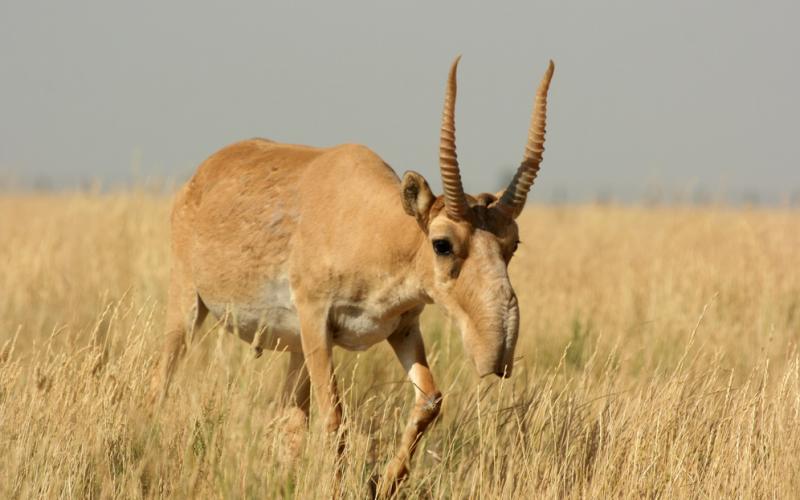Surprisingly high consumption of “antelope horn” products from critically endangered saiga antelope in Singapore

A recent study by ASE’s Asst Prof Janice Lee and colleagues found that traditional Chinese medicine (TCM) products containing horn from the critically endangered saiga antelope are consumed by as much as 19% of Singapore’s Chinese population. However, most of these consumers are unaware of the link between products marketed as ‘ling yang’ (羚羊), or ‘antelope's tea’ and the saiga antelope. As is often the case with products from wildlife trade, the consumer is separated from the source of the product by a trade chain spanning multiple countries, creating a significant disconnection between consumer and product source, and low consumer awareness, says Hunter Doughty, lead researcher of the study and based at Oxford University.
The saiga antelope is a small migratory species with a characteristic large humped nose. It used to roam the plains of Central Asia in numbers over a million up until the early 1990s, but today’s population is estimated to only around 120,000 animals. The reasons for the drastic drop in numbers are several, with poaching driven by increased demand in TCM being the largest continuous threat. Disease outbreaks have also had devastating effects on the saiga antelope population. Saiga trade has been regulated by the Convention on International Trade in Endangered Species of Wild Fauna and Flora since 1995.
The researchers take an interdisciplinary approach to this environmental problem, starting with collecting data the on how widespread the demand is for TCM products containing saiga horn by interviewing consumers. They choose to conduct the study in Singapore because it is one of the largest markets for saiga horn products in the world (along with China and Hong Kong), and perhaps no wonder since saiga horn is considered to have a cooling effect. It is used primarily to treat fever and heatiness but also other imbalances. It is legal to sell within Singapore, and can be found in a variety of forms including whole horns, horn shavings, capsules, and as a bottled drink (often listed as "Cornu Saiga tataricae" on the ingredients list).
The goal for this research is to provide reliable information to aid pragmatic and timely approaches to solve a conservation issue, says Doughty. But she is aware that consumers having access to information does not automatically mean they change their behaviour (a phenomena known as the value-action gap). Hence, she is creating a conceptual framework based on things like consumer purchase habits, psychology and marketing theory, to understand the greater social and cultural picture behind the product usage. And it looks like Singaporeans could use a little help to make informed decisions when purchasing these health products; after interviewing over 2,200 Chinese Singaporeans aged 18 and above, the researchers were surprised to find that as many as 19% bought products containing saiga horn. Doughty points out that many do not know where ling yang comes from, or that the animal is endangered.
Luckily for the aware consumer, there are several good, more sustainable alternatives to ling yang in TCM, such as chrysanthemum tea, barley water or honeysuckle. Domestic animal options such as goat and sheep horn are also better choices than the wild product.
Though the saiga antelope population is sensitive due to being a migratory species moving across international borders (meaning conservation efforts need to be internationally coordinated) and also to habitat loss and fragmentation, there is good hope that the species can recover given that the right efforts are put in. Saigas can breed just one year after they are born, meaning numbers could be brought up fairly quickly. In fact, it has already started to happen thanks to all five saiga home countries agreeing to implement strict conservation action-plans in 2006, including some export trade suspensions and legislation on saiga hunting and product sales. If demand in countries like Singapore goes down, it would make poaching less likely, and that could help save the record-small population of remaining saiga antelope.
Read more about Hunter Doughty and Janice Lee
Read a Straits Times article on the saiga antelope study here














/enri-thumbnails/careeropportunities1f0caf1c-a12d-479c-be7c-3c04e085c617.tmb-mega-menu.jpg?Culture=en&sfvrsn=d7261e3b_1)

/cradle-thumbnails/research-capabilities1516d0ba63aa44f0b4ee77a8c05263b2.tmb-mega-menu.jpg?Culture=en&sfvrsn=1bc94f8_1)

7e6fdc03-9018-4d08-9a98-8a21acbc37ba.tmb-mega-menu.jpg?Culture=en&sfvrsn=7deaf618_1)
